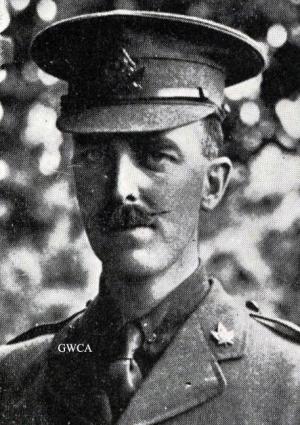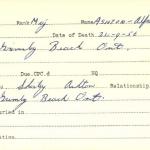BX September 14, 1916
Brantford Casualties – Major A.N. Ashton and Pte. A. McIntyre Are Reported Wounded
The heavy fighting in the Somme sector has been responsible for the wounding of two more Brantford men, Major Alfred Nelles Ashton and Pte. Archibald McIntyre. A telegram from the war office at Ottawa acquainted Mrs. Ashton with the fact that her husband had been wounded on September 9, in the Somme fighting. No particulars other than this has been received as yet, but further word is expected soon, as the message stated that particulars would follow.
Major Ashton who left here in March last year with the 36th Battalion under command of his brother, now Brigadier Ernest Charles Ashton, is now with the 4th Battalion, 1st Brigade. He was for some time commander of the 36th Battalion, and left for active service in France only a few weeks ago. Previous to enlistment Major Ashton was principal at the Mohawk Institute and was prominently connected with the Dufferin Rifles. As the message did not state “seriously wounded,” his many friends will hope that his injuries are not severe.
BX October 10, 1916
Major Nelles Ashton is Home on Sick Leave; Shot by Sniper – Had Been but Four Days on Firing Line When Bullet Struck Revolver Butt and Ricocheting, Grazed His Abdomen – Revolver Was Gift of City of Brantford
The first Brantford officer to arrive home from the Somme sector, Major A. Nelles Ashton, is back on sick leave, having been wounded by a German sniper while returning to the trenches with orders one evening. Major Ashton, despite his injury is looking bronzed and hearty after his war experiences.
About nine weeks ago in company with some 120 majors, Major Ashton was sent over to France. Here he was attached to the “Mad Fourth” battalion, in command of “C” Company. As he reached the battalion it was just leaving the Ypres salient for the Somme region and it was about four weeks after that the firing line in this sector was reached.
After five days in the reserve Major Ashton spent five days with his company in the firing line and experienced an exceptionally hard time, being shelled incessantly. Many casualties were suffered during these engagements, which were principally between the artillery.
It was on the evening of September 8, after he had been on the firing line for four days that Major Ashton was wounded and experienced a most miraculous escape. It was during an artillery engagement and he was returning from the battalion headquarters to the front line with orders when a German sniper caught him.
Revolver Saved Him
His escape he owes to a revolver presented to him before leaving for the front, by the city of Brantford. The bullet struck the butt of the revolver, shattering it and then grazed the Brantford officer’s stomach. The bullet caused a contusion of the abdomen which eventually was the cause of his being invalided home.
To a reporter from The Expositor this morning Major Ashton showed his raincoat which he had on when he was shot and the revolver which saved his life. The bullet put three holes in the raincoat, apparently going downwards after striking. The top of the butt of the revolver was badly smashed. Major Ashton, after being wounded, passed through three hospitals before being invalided home for a rest, but he is now much improved.
Few Originals Left
Very few of the original Fourth Battalion remains, according to Major Ashton. The battalion is now badly mixed up, having a large number of the 76th and 36th Battalion men in it. As to conditions in the Somme region, where the fighting is now raging so fiercely, he said that the trenches were while he was there in a very bad condition. There were no traverse trenches, but chiefly connected shell holes. Part of them were old German trenches. Absolutely no sleep was possible in the front line trenches. They were very muddy, and there were no dugouts for the men.
At nights the men were engaged in building “saps” toward the German trenches and were within 20 yards of them. Despite this hazardous work, the casualties were light, he stated. They left the firing line a few days later, going back to rest after being relived by the First Battalion of the First Brigade.
Wonderful Morale
The morale of the Canadian “Tommy” at the front, Major Ashton described as absolutely wonderful. They do everything in the best of spirits and never have any trouble with their officers. From what he had seen of the Germans their morale did not appear to have been weakened. But then the Germans lined up against them in the Somme were the Prussian Guards, the very flower of the enemy army.
German Confidence
To the enquiry of the reporter as to the duration of the war, Major Ashton told the following: “On Sept. 10 the battalion relieving the 4th Battalion took some 200 prisoners, all members of the Prussian Guard. They were a fine, well-set up lot of men. They believed that they would win the war, and if they did not it would be a draw. One of the Germans asked the question what would become of him. On being told that he would probably be sent to England, he answered that it was impossible, as the Germans controlled the English Channel. They also have the impression that our troops are all marooned in France.” Speaking for himself, Major Ashton could not see any chance of the war ending this year. Preparations for the winter campaign, he stated, had not been begun yet.
His Progress
Major Ashton left here as second in command of the 36th Battalion, being under his brother, Lieut.-Col. E.C. Ashton. About the middle of September, 1915, he was advanced to the command and commanded it until attached to the 4th Battalion. This was not Major Ashton’s first spell in the trenches. In December, 1915, he was with the 4th Battalion at Wulverghrem, opposite Messines. He was then attached for three weeks for instructional purposes. The casualties amongst the officers at the front are very heavy. To take these places Major Ashton was one of the 120 majors sent over. These officers are attached to the various battalions, and do duty as required. As to the reports that there were many unattached officers in England, he said there were at one time but not now.
British Control the Air
“It looks to me as if we had control of the air,” said Major Ashton, in telling of air fights witnessed. Inside of half an hour one morning he witnessed three German aeroplanes brought down. When a German plane appears in the air several Allied planes put out after it. Then in the artillery fighting the Canadians are putting over about 30 shells to every one of the Germans.
After being wounded Major Ashton was passed on through four hospitals, arriving in London about the 13th of September. He reports most excellent treatment throughout; the wounded being carefully looked after in all the hospitals.
Returned On Olympic
It was on the S.S. Olympic that brought back such celebrities as Lieut.-Gen. Sir Sam Hughes, Minister of Militia; Premier Hearst and Dr. Pyne that Major Ashton returned. There were 1200 wounded Canadians on this boat, including a number of nurses and doctors.
Major Ashton met Lieut.-Col. Mac Colquhoun in London. He had reported back in France, but did not take over the command, returning to England. He visited Major Ashton in the hospital. Major Ashton also stayed a couple of days with his brother, Lieut.-Col. Ashton, who is in charge of the Third Canadian Training Brigade at Hyde.
Major “Bert” Newman of Brantford, formerly with the 19th Battalion, Major Ashton states, is now doing duty with the permanent medical board. In London he also saw Lieut. Eric Cockshutt, who is attending training school. He was looking fine.
Major Ashton’s orders are for him to report back in London on November 22.


